Abstract
1. A method is described for the measurement of phenobarbitone (PB) by reversed phase high performance liquid chromatography (h.p.l.c.) from small samples of whole blood dried onto filter paper strips. 2. The disposition of PB given prophylactically to young children with severe malaria on parenteral quinine is contrasted with that in aparasitaemic Kenyan children on no antimalarial drugs. There were no differences in the disposition of PB between the two groups. 3. Peak blood PB concentrations were equal to or greater than 15 mg l-1 in 27% of the patients on quinine and 23% of those not on quinine; a concentration of 10 mg l-1 was achieved or exceeded by 100% and 92% of each group, respectively, and was maintained for 39 +/- 24 h (mean +/- s.d.), and 33 +/- 21 h, respectively. 4. In an open, dose-finding study, the progress of young children with cerebral malaria given prophylactic PB (10 mg kg-1), was contrasted with that of controls given no seizure prophylaxis. 5. The drug had no apparent effect on depth or duration of coma, but neither was the incidence of seizures reduced. 6. A controlled trial of prophylactic PB in young children with cerebral malaria is needed, but a larger dose than 10 mg kg-1 should be studied.
Full text
PDF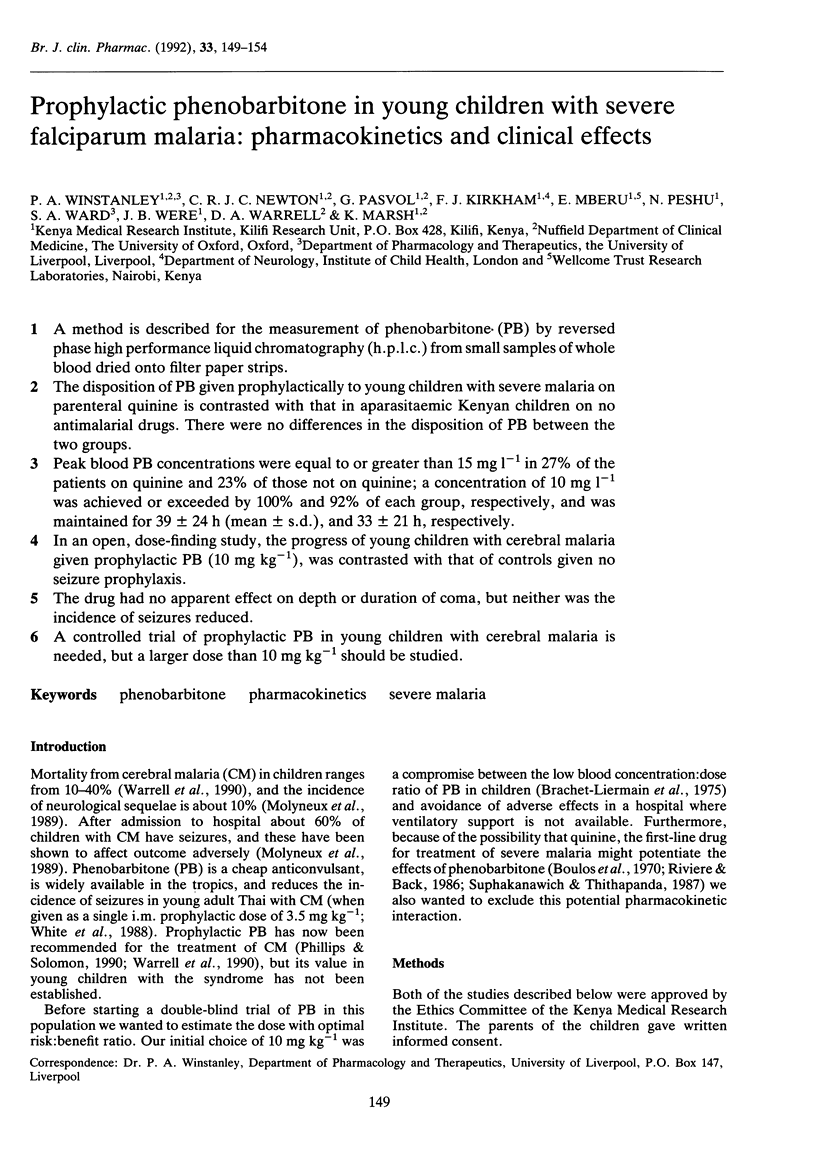
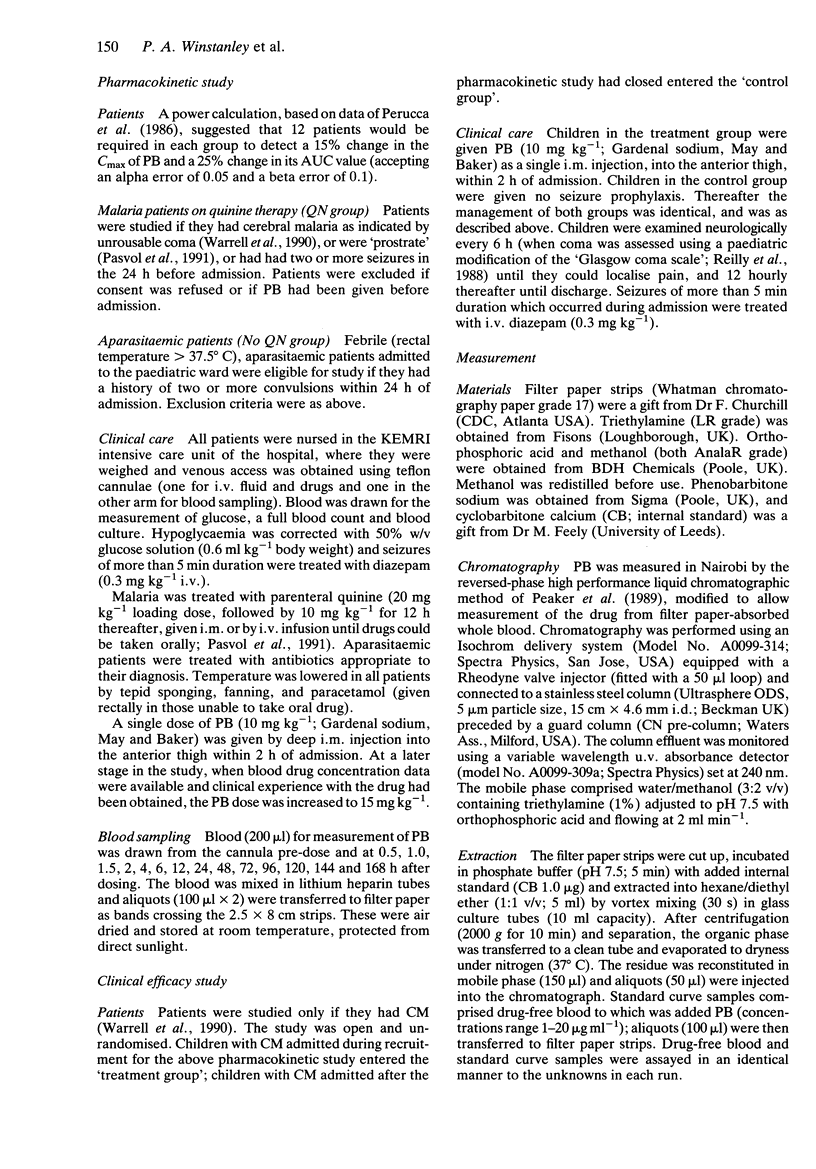
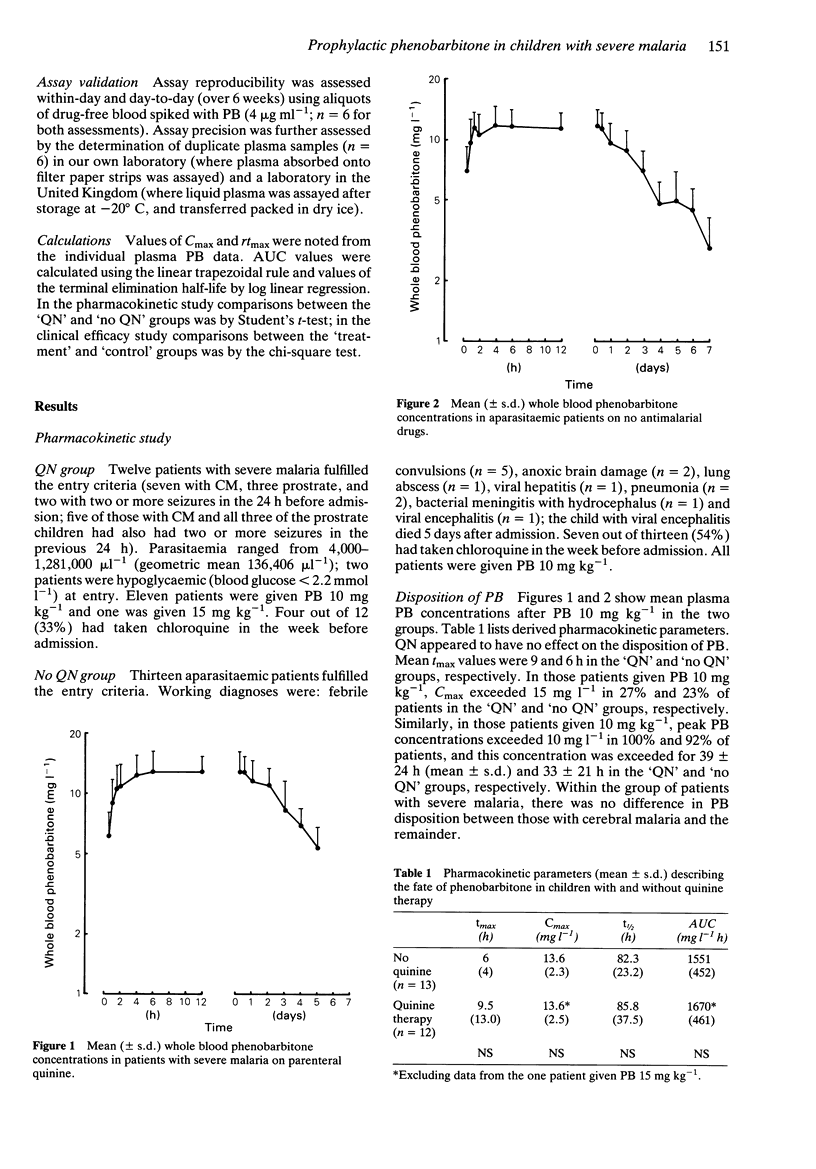
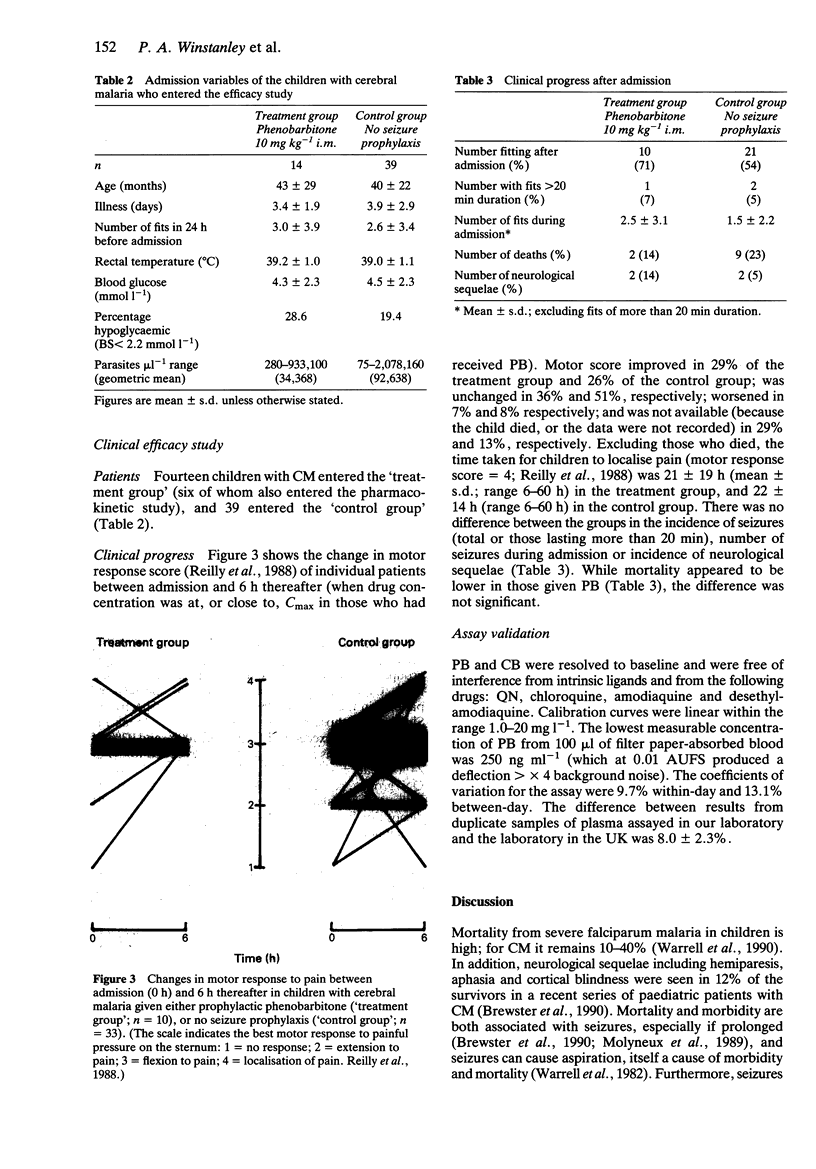
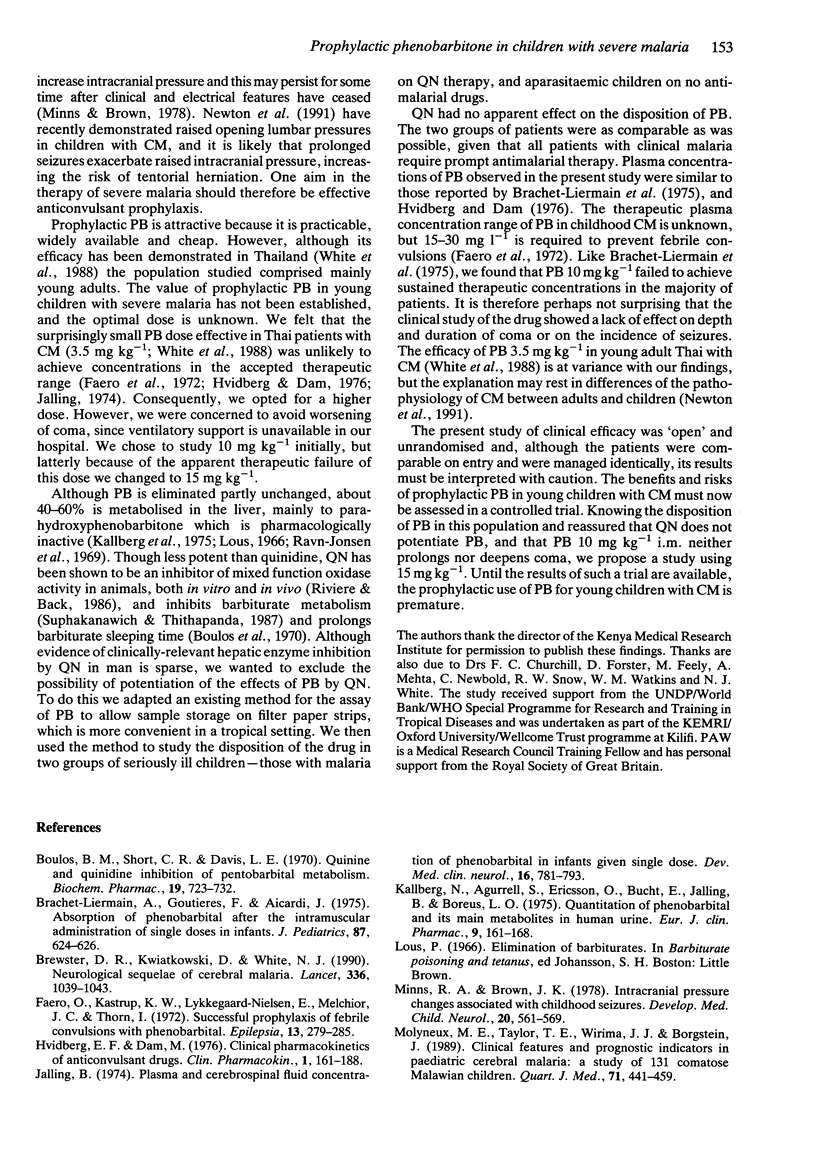
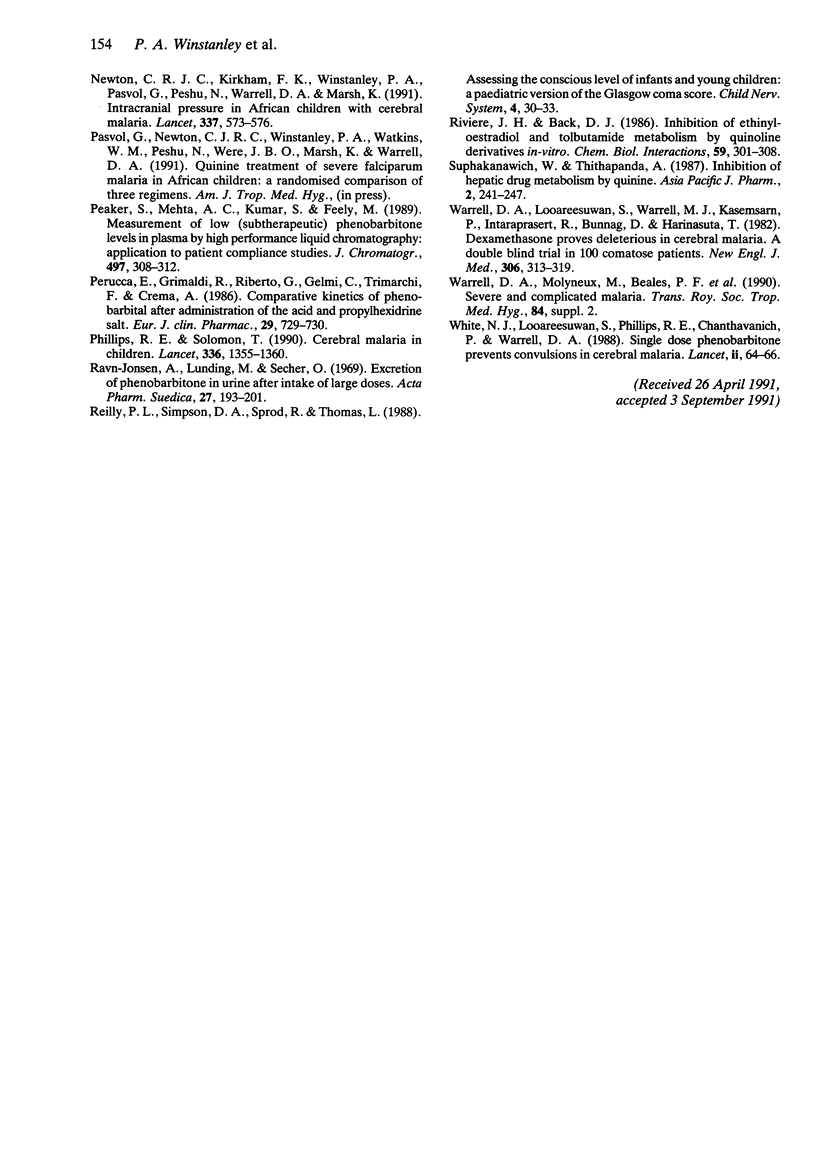
Selected References
These references are in PubMed. This may not be the complete list of references from this article.
- Boulos B. M., Short C. R., Davis L. E. Quinine and quinidine inhibition of pentobarbital metabolism. Biochem Pharmacol. 1970 Mar;19(3):723–732. doi: 10.1016/0006-2952(70)90235-2. [DOI] [PubMed] [Google Scholar]
- Brachet-Liermain A., Goutieres F., Aicardi J. Absorption of phenobarbital after the intramuscular administration of single doses in infants. J Pediatr. 1975 Oct;87(4):624–626. doi: 10.1016/s0022-3476(75)80840-7. [DOI] [PubMed] [Google Scholar]
- Brewster D. R., Kwiatkowski D., White N. J. Neurological sequelae of cerebral malaria in children. Lancet. 1990 Oct 27;336(8722):1039–1043. doi: 10.1016/0140-6736(90)92498-7. [DOI] [PubMed] [Google Scholar]
- Faero O., Kastrup K. W., Lykkegaard Nielsen E., Melchior J. C., Thorn I. Successful prophylaxis of febrile convulsions with phenobarbital. Epilepsia. 1972 Apr;13(2):279–285. doi: 10.1111/j.1528-1157.1972.tb05262.x. [DOI] [PubMed] [Google Scholar]
- Hvidberg E. F., Dam M. Clinical pharmacokinetics of anticonvulsants. Clin Pharmacokinet. 1976;1(3):161–188. doi: 10.2165/00003088-197601030-00001. [DOI] [PubMed] [Google Scholar]
- Jalling B. Plasma and cerebrospinal fluid concentrations of phenobarbital in infants given single doses. Dev Med Child Neurol. 1974 Dec;16(6):781–793. [PubMed] [Google Scholar]
- Kallberg N., Agurell S., Ericsson O., Bucht E., Jalling B., Boréus L. O. Quantitation of phenobarbital and its main metabolites in human urine. Eur J Clin Pharmacol. 1975 Dec 19;9(2-3):161–168. doi: 10.1007/BF00614013. [DOI] [PubMed] [Google Scholar]
- Minns R. A., Brown J. K. Intracranial pressure changes associated with childhood seizures. Dev Med Child Neurol. 1978 Oct;20(5):561–569. doi: 10.1111/j.1469-8749.1978.tb15274.x. [DOI] [PubMed] [Google Scholar]
- Molyneux M. E., Taylor T. E., Wirima J. J., Borgstein A. Clinical features and prognostic indicators in paediatric cerebral malaria: a study of 131 comatose Malawian children. Q J Med. 1989 May;71(265):441–459. [PubMed] [Google Scholar]
- Newton C. R., Kirkham F. J., Winstanley P. A., Pasvol G., Peshu N., Warrell D. A., Marsh K. Intracranial pressure in African children with cerebral malaria. Lancet. 1991 Mar 9;337(8741):573–576. doi: 10.1016/0140-6736(91)91638-b. [DOI] [PubMed] [Google Scholar]
- Peaker S., Mehta A. C., Kumar S., Feely M. Measurement of low (sub-therapeutic) phenobarbitone levels in plasma by high-performance liquid chromatography: application to patient compliance studies. J Chromatogr. 1989 Dec 29;497:308–312. doi: 10.1016/0378-4347(89)80034-9. [DOI] [PubMed] [Google Scholar]
- Perucca E., Grimaldi R., Ruberto G., Gelmi C., Trimarchi F., Crema A. Comparative kinetics of phenobarbital after administration of the acid and the propylhexedrine salt (barbexaclone). Eur J Clin Pharmacol. 1986;29(6):729–730. doi: 10.1007/BF00615968. [DOI] [PubMed] [Google Scholar]
- Phillips R. E., Solomon T. Cerebral malaria in children. Lancet. 1990 Dec 1;336(8727):1355–1360. doi: 10.1016/0140-6736(90)92903-u. [DOI] [PubMed] [Google Scholar]
- Ravn-Jonsen A., Lunding M., Secher O. Excretion of phenobarbitone in urine after intake of large doses. Acta Pharmacol Toxicol (Copenh) 1969;27(2):193–201. doi: 10.1111/j.1600-0773.1969.tb00506.x. [DOI] [PubMed] [Google Scholar]
- Reilly P. L., Simpson D. A., Sprod R., Thomas L. Assessing the conscious level in infants and young children: a paediatric version of the Glasgow Coma Scale. Childs Nerv Syst. 1988 Feb;4(1):30–33. doi: 10.1007/BF00274080. [DOI] [PubMed] [Google Scholar]
- Riviere J. H., Back D. J. Inhibition of ethinyloestradiol and tolbutamide metabolism by quinoline derivatives in vitro. Chem Biol Interact. 1986 Oct 1;59(3):301–308. doi: 10.1016/s0009-2797(86)80075-8. [DOI] [PubMed] [Google Scholar]
- Warrell D. A., Looareesuwan S., Warrell M. J., Kasemsarn P., Intaraprasert R., Bunnag D., Harinasuta T. Dexamethasone proves deleterious in cerebral malaria. A double-blind trial in 100 comatose patients. N Engl J Med. 1982 Feb 11;306(6):313–319. doi: 10.1056/NEJM198202113060601. [DOI] [PubMed] [Google Scholar]
- White N. J., Looareesuwan S., Phillips R. E., Chanthavanich P., Warrell D. A. Single dose phenobarbitone prevents convulsions in cerebral malaria. Lancet. 1988 Jul 9;2(8602):64–66. doi: 10.1016/s0140-6736(88)90002-5. [DOI] [PubMed] [Google Scholar]


